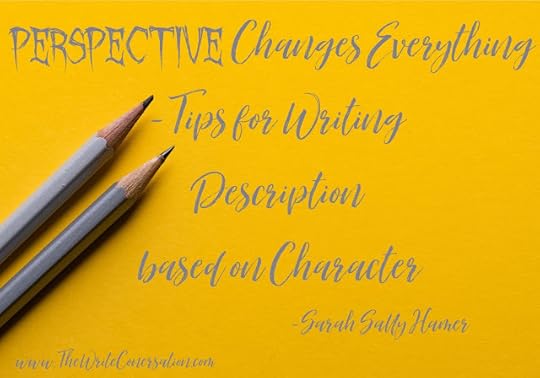Perspective Changes Everything—Tips for Writing Description based on Character

by Sarah Sally Hamer @SarahSallyHamer
Writers use words to paint pictures. Unlike screenwriters and the cadre of directors, set and costume designers, and cinematographers who use an entirely different set of tools, we writers have to describe the windy hillside, the absolute cold of space, the golden plains of grain. But it’s not quite that easy. We also have to tell the story through our characters and their feelings. Each character is unique. Or should be! So their perspective should reflect that uniqueness. My two characters from my previous blogs about Deep Point of View are going to help me explain. Belinda is a soon-to-be ex-wife, walking down the hall of the courthouse. Susan is at the visitation for her young daughter’s funeral.
Use their deep point of view.Belinda is angry. Actually, “angry” doesn’t even begin to describe what she feels. She’s a volcano with a magma chamber five miles deep, just waiting to explode and melt her ex-husband and his new girlfriend into unidentifiable crisps.
So, when we describe the hallway of the courthouse, we won’t talk about the polished wooden benches and the swoosh of doors shutting behind her. Instead, Belinda’s perception will be skewed by her emotion. The hallway will close in on her, with the echo of each step taking her more deeply into a prison she can’t escape from. The doors will seem like open mouths, disgorging or absorbing people whose chatter doesn’t make any sense. Even if someone smiled at her, she’d probably see it as a grimace with garish teeth. When she locates her husband, his arm around that much-younger-than-him floozy, Belinda’s vision sharpens and every painted fingernail and bleached hair, and especially that tight skirt, comes into perfect view.
Nothing else matters. Not the other people standing around, not the clock on the wall, not the brand-new blue carpet. ONLY the things she needs to see will be seen and described. And they will be defined by how she feels.
Everything around Susan, the grieving mother, droops and weeps, from the draperies to the plants. The fragrance of the flowers makes her stomach churn. The sun might be shining but the stained glass windows would reflect it as deep, frightening shadows. Her narrow perception, and therefore the description the author includes, won’t include the faces of the people in the receiving line. She may see their hands as she shakes them, but she’ll stand stiffly, not allowing anyone to hug her, so she doesn’t break down. She clings to her daughter’s favorite bear, her one solace, loving the torn ear and the missing eye, remembering how beloved it was.
The things I’m describing are just things. Because Belinda is an attorney, she’s walked down that courthouse hallway thousands of times, only noticing what she needed to. The bear Susan is holding was a nuisance to her when Chelsea spit up all over it and it needed to be washed or the day Chelsea left it at the toy store and they had to call a manager to unlock the door because she couldn’t sleep without it.
Readers will not only pay attention to the description, they’ll feel it too.
Are these important details? Only if you want to really show your character’s perspective, which delineates everything they see, hear, taste, touch, or smell. A happy character sees the world in a happy way. But an unhappy character sees nothing beyond what their emotion allows them.
How about your characters? How do they see their world? How does that perspective change as they do?
TWEETABLEPerspective Changes Everything—Tips for #Writing Description based on Character - @SarahSallyHamer on @EdieMelson (Click to Tweet)
Tips for #writing description using deep POV - @SarahSallyHamer on @EdieMelson (Click to Tweet)
 Sarah (Sally) Hamer is a lover of books, a teacher of writers, and a believer in a good story. Most of all, she is eternally fascinated by people and how they 'tick'. She’s passionate about helping people tell their own stories, whether through fiction or through memoir. Writing in many genres - mystery, science fiction, fantasy, romance, medieval history, non-fiction – she has won awards at both local and national levels, including two Golden Heart finals.
Sarah (Sally) Hamer is a lover of books, a teacher of writers, and a believer in a good story. Most of all, she is eternally fascinated by people and how they 'tick'. She’s passionate about helping people tell their own stories, whether through fiction or through memoir. Writing in many genres - mystery, science fiction, fantasy, romance, medieval history, non-fiction – she has won awards at both local and national levels, including two Golden Heart finals.A teacher of memoir, beginning and advanced creative fiction writing, and screenwriting at Louisiana State University in Shreveport for over sixteen years, she also teaches online for Margie Lawson at www.margielawson.com. Sally is a free-lance editor and book coach at Touch Not the Cat Books, with many of her students and clients becoming successful, award-winning authors.
You can find her at hamerse@bellsouth.netor www.sallyhamer.blogspot.com
I wish to express gratitude to the giants whose shoulders I stand on and who taught me so much about the writing craft. I would list every one, if it were only possible.
Published on September 03, 2019 22:00
No comments have been added yet.



